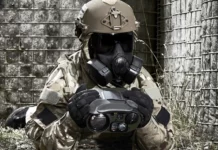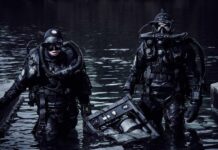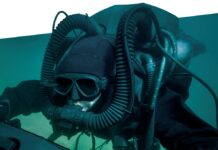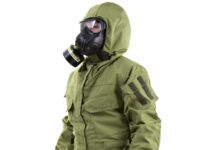CBRN respiratory protection is intended to give the user safe and clean air to breathe. Various approaches to achieving this end have both advantages and disadvantages. A major problem is that the disadvantages, in certain situations, end up with the user being dead, disabled, or seriously injured. Lots of engineering has gone into respiratory protection to make sure this does not happen, but the subject of how to protect soldiers and emergency responders from inhaled CBRN threats needs, in this correspondent’s mind, a bit of a fresh look.
Two main types of respiratory protection
Let us examine two prevalent but different types of respiratory protection. Most military-style protective mask can be described as ‘negative pressure air purifying respirators’. Some militaries use the word ‘mask’ (USA) while others (such as the UK) use ‘respirator’, but this article will use the terms interchangeably. Regardless of term, filter masks/respirators seal to the wearer’s face, with straps around the head. When the wearer inhales, there is, briefly, a state lower air pressure inside the mask and lungs. This negative pressure is enough to draw in air through a filter, which uses various methods and materials to let in breathable air but stop particles, vapours, gases, and aerosols. When the wearer exhales, the positive pressure of exhalation forces the exhalation air out through simple valves.
![An Airman with the 127th Civil Engineer Squadron participates in a gas mask fit test at Selfridge Air National Guard Base, Michigan, on 14 October 2023. [US ANG/Senior Master Sgt Dan Heaton]](https://euro-sd.com/wp-content/uploads/2025/05/Mask-fit-test_US-ANGSenior-Master-Sgt-Dan-Heaton-Kopie-737x1024.jpg)
The other type of protection is a type we have all seen worn by firefighters. These are often referred to as self-contained breathing apparatus (SCBA). They have a facepiece that is, in many ways, very similar to filter-based masks, but they can be described as ‘positive pressure supplied air respirators’. The breathing air comes generally from a tank worn on the back, or occasionally, in occupational safety settings, a long supply hose. Such devices have a regulator that supplies air at positive pressure. When you inhale, the small pressure difference is enough to trigger the regulator valve, which floods the facepiece with air at a small positive pressure difference.
The advantages and disadvantages of SCBA are many. It provides breathable air in environments where there may not be enough oxygen to sustain life, or substances that are difficult to screen out with a filter. The smallest leak in the seal or breach in the mask results in pressurised air filling the space between the face and the facepiece, pushing hazards out. As a result, exact fits are less important. They also provide far less breathing resistance than a filter mask. On the other hand, their disadvantages are as notable as the advantages. An air tank is heavy and only supplies a limited duration of air – when they run out, they are truly out. Filters, on the other hand, last a long time. SCBA systems are typically designed for 30-45 minutes of time, and that time may also need to be used for getting to and from the hazardous area decontamination after coming out of a hazardous situation. In CBRN environments, these systems are good for a quick entry to collect samples, rescue victims, or mitigate a hazard, but time constraints mean that serious extensive work plans require numerous entries and exits, logistics for air tank replacement, and rotation of personnel. This is why filter respirators are used in military environments, and SCBA is only seen among specialist CBRN technicians in military settings.
![Traditional firefighting Self-Contained Breathing Apparatus (SCBA) provides a high degree of protection but does not last long enough for military operations and is generally considered too heavy. [USAF/Eric M. White]](https://euro-sd.com/wp-content/uploads/2025/05/Firefighters_USAFEric-M-e-1024x682.jpg)
Protection factor
We are all, by now, familiar with the concept of a protection factor for sunscreen. Respiratory protection also has a concept known to the safety regulators as ‘assigned protection factor’ (APF). The APF is the degree to which a particular respirator is likely to reduce the level of respirable hazard to the wearer, based on numerous factors. APF is set by regulators based on studies, but the real protection factor on a given day may be higher or lower based on factors such as having the wrong size mask, how tight the straps are, hair stuck in the seal, or damage to the facepiece. There is entire market segment of fit validation equipment that tests the protection factor of a particular person wearing a particular respirator on a particular day.
APFs are used for general regulatory determinations about which category of protection is required for a particular occupational safety environment in the civil workplace. When you start comparing APFs between military filter masks and SCBA, the difference is stark. In the USA, regulators evaluate well-fitted filter masks as having an APF of 50. This means that the respiratory hazard is reduced by a factor of 50 on average. On the other hand, the APF of a pressure-demand SCBA is rated at 10,000 – a 200-fold improvement in protection. It should be noted quite strongly that many manufacturers claim that their masks have a much higher protective factor, when properly fitted and tested, than the default APF. This is undoubtedly true and much technical literature backs this up. Yet such statements must also be balanced against field conditions, where soldiers may have been accumulating dirt and facial hair (which can interfere with a fit), mistreating their PPE, and possibly wearing their respirator the wrong way.
When it comes to chemicals (or biological matter) with high levels of danger in high concentration, is an APF of 50 really good enough? We can work a very basic scenario, although it will require some number-crunching. Looking through one available study, an explosion of a cylinder of Chlorine gas (much like that dropped by Bashar al-Assad’s helicopters in Syria, most notably during 2018) can create a modest area of a concentration of 1,000 parts per million (ppm) and a much larger area where concentration may be 30 ppm, depending on confinement, wind and other conditions. For a person who is unprotected and remains in the gas, the 1,000 ppm concentration could be fatal and the 30 ppm concentration would be enough for minor injury, serious cough, and eye irritation. In other words, enough to keep a soldier from fighting very well. For a person wearing a respirator with an APF of 50, that 1,000 ppm zone would be reduced to 20 ppm, still quite irritating, possibly temporarily incapacitating, but not lethal. That 30 ppm zone would be reduced to 0.6 ppm, still enough for a dry throat and some eye irritation. For the person wearing SCBA with an APF of 10,000, the threat is reduced to negligible.
![A crew member is fitted for a gas mask aboard aircraft carrier USS Harry S. Truman (CVN 75), on 16 July 2015. Fit and field conditions can greatly impact the ‘real’ APF, which may vary from the ‘boilerplate’ protection figure. [US Navy/MC3 L.C. Edwards]](https://euro-sd.com/wp-content/uploads/2025/05/Mask-at-sea_US-NavyMC3-L.C-w-1024x683.jpg)
Fixing the problem
One way to fix the problem is to make masks better. Industry has been doing that for a long time and the existing generation of filter respirators is much better that the Vietnam War-era masks that this correspondent was using decades ago. Yet the conceptual flaw remains. User error and field conditions mean that a negative-pressure often mask fails in a mode that lets hazards in every time the user breathes. This is obviously a bad thing. In addition, there will always be some percentage of the population that will not easily wear one of the handful of sizes available and will struggle to get a good fit.
At the other end, SCBA are too large, too heavy, and run out of air too quickly, so they are not suitable for combat missions, except for perhaps some sort of special operations raid on a laboratory complex. Some hybrid approaches are available. For air crew and combat vehicle crewmen, there have long been specialist masks that plug into a supplied breathing air system and operate in a positive pressure way as long as the crewman is plugged in. However, these are a minority of use cases. Some SCBA systems have been developed that have a back-up filter and the operator can switch between supplied air and filter. (This correspondent used one such system from InterSpiro (USA) for five years.) Yet such systems, while useful in certain operational niches, rely on an air bottle that is too big for military use.
![Powered Air Purifying Respirators (PAPRs) strike a balance between traditional negative pressure respirators, and SCBA, providing superior protection to the former while being less bulky and allowing longer-duration operations than the latter. [USAF/Senior Airman Ryan Mancuso]](https://euro-sd.com/wp-content/uploads/2025/05/USMC-PAPR-as-part-of-Kit_USMCSgt-Jessica-Quezada-Kopie-1024x682.jpg)
PAPRs are not without their disadvantages. Motors can break, batteries die, and they are heavier than regular filter masks. But they are not anywhere near as heavy as SCBA and if a blower fails or battery dies, the mask can still work like an older filter mask. They will make some noise, but modern engineering can work on that issue. Battery life is also an issue, but that can be worked on as well.
The marketplace
There are rumblings in this market sector. PAPRs have been made and used in civilian settings for some decades. Many of the major manufacturers have produced PAPRs. Some are now made for military specs, while others could be easily modified for military procurement. Avon Protection (UK) makes several PAPR systems for military and paramilitary use. Scott Safety (US, a division of 3M) has a robust product line-up, with many emergency response products that could easily find a military niche. Air Boss (Canada) has adapted a long-standing civil product line for military use. Dräger (Germany) has civilian PAPRs, but given its expertise, could probably field a military product if such demand existed. Mira Safety (USA) is pushing hard in this field and is one to watch. It has been several years since I have done a full survey of respiratory protection for this magazine. It will be interesting to see how much of the marketing effort is given over to PAPRs in a year or two.
In conclusion, using a powered air purifying respirator for military CBRN protection is a useful approach and one that builds on existing product lines. What needs to change is on the demand side of the equation. Once CBRN defensive doctrine adapts a bit, procurement officials may be convinced be that the PAPR’s advantages, particularly a 20:1 improvement in protective factor, outweigh the disadvantages. If a 20:1 improvement in body armour or small-arms ammunition came along, MoDs around the world would be falling over themselves to adopt it. Having scanned the entire CBRN defence horizon for some years now, as a career specialist in this field it seems clear that this is the most likely sub-segment of CBRN defence where a relatively small change can make a big difference.
![A PAPR shown as part of USMC Alert Contingency Marine Air-Ground Task Force (ACM) issued equipment, during exercise Habu Sentinel 16 at Marine Corps Air Station Iwakuni, Japan, on 8 June 2016. [USMC/Sgt Jessica Quezada]](https://euro-sd.com/wp-content/uploads/2025/05/PAPR-Fit_USAFSenior-Airman-Ryan-Mancuso-Kopie-1024x534.jpg)


![Gas Mask Fit Test An Airman with the 127th Civil Engineer Squadron participates in a gas mask fit test at Selfridge Air National Guard Base, Michigan, on 14 October 2023. [US ANG/Senior Master Sgt Dan Heaton]](https://euro-sd.com/wp-content/uploads/2025/05/Mask-fit-test_US-ANGSenior-Master-Sgt-Dan-Heaton-Kopie.jpg)

![Nanotechnology: Threats and prospects in the CBRN sector US Airmen from the 426th Air Base Squadron conducting chemical, biological, radiological and nuclear (CBRN) training at KNM Harald Haarfagre, Stavanger, Norway, on 20 May 2025. [USAF/A1C Adam Enbal]](https://euro-sd.com/wp-content/uploads/2025/09/CBRN-Norway_USAFA1C-Adam-Enbal-Kopie-218x150.jpg)
![Toxic legacies of warfare: Burn pits and other health hazards A ‘Ranch Hand’ UC-123 deploying a defoliant (either Agent White or more likely Agent Orange) to clear a roadside in central South Vietnam in 1966. [USAF]](https://euro-sd.com/wp-content/uploads/2025/07/Ranch-Hand_USAF-Kopie-218x150.jpg)






